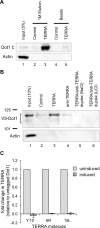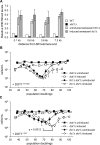TERRA and the histone methyltransferase Dot1 cooperate to regulate senescence in budding yeast
- PMID: 29649255
- PMCID: PMC5896980
- DOI: 10.1371/journal.pone.0195698
TERRA and the histone methyltransferase Dot1 cooperate to regulate senescence in budding yeast
Abstract
The events underlying senescence induced by critical telomere shortening are not fully understood. Here we provide evidence that TERRA, a non-coding RNA transcribed from subtelomeres, contributes to senescence in yeast lacking telomerase (tlc1Δ). Levels of TERRA expressed from multiple telomere ends appear elevated at senescence, and expression of an artificial RNA complementary to TERRA (anti-TERRA) binds TERRA in vivo and delays senescence. Anti-TERRA acts independently from several other mechanisms known to delay senescence, including those elicited by deletions of EXO1, TEL1, SAS2, and genes encoding RNase H enzymes. Further, it acts independently of the senescence delay provided by RAD52-dependent recombination. However, anti-TERRA delays senescence in a fashion epistatic to inactivation of the conserved histone methyltransferase Dot1. Dot1 associates with TERRA, and anti-TERRA disrupts this interaction in vitro and in vivo. Surprisingly, the anti-TERRA delay is independent of the C-terminal methyltransferase domain of Dot1 and instead requires only its N-terminus, which was previously found to facilitate release of telomeres from the nuclear periphery. Together, these data suggest that TERRA and Dot1 cooperate to drive senescence.
Conflict of interest statement
Figures





Similar articles
-
Yeast Npl3 regulates replicative senescence outside of TERRA R-loop resolution and co-transcriptional processing.Nucleosides Nucleotides Nucleic Acids. 2025;44(6):486-506. doi: 10.1080/15257770.2024.2374023. Epub 2024 Jul 8. Nucleosides Nucleotides Nucleic Acids. 2025. PMID: 38976968
-
Induction and relocalization of telomeric repeat-containing RNAs during diauxic shift in budding yeast.Curr Genet. 2018 Oct;64(5):1117-1127. doi: 10.1007/s00294-018-0829-5. Epub 2018 Mar 22. Curr Genet. 2018. PMID: 29569051
-
Inactivation of the Sas2 histone acetyltransferase delays senescence driven by telomere dysfunction.EMBO J. 2010 Jan 6;29(1):158-70. doi: 10.1038/emboj.2009.314. Epub 2009 Oct 29. EMBO J. 2010. PMID: 19875981 Free PMC article.
-
Transcriptional regulation of telomeric non-coding RNA: implications on telomere biology, replicative senescence and cancer.RNA Biol. 2010 Jan-Feb;7(1):18-22. doi: 10.4161/rna.7.1.10257. Epub 2010 Jan 6. RNA Biol. 2010. PMID: 19901520 Review.
-
Telomeric noncoding RNA: telomeric repeat-containing RNA in telomere biology.Wiley Interdiscip Rev RNA. 2014 May-Jun;5(3):407-19. doi: 10.1002/wrna.1220. Epub 2014 Feb 12. Wiley Interdiscip Rev RNA. 2014. PMID: 24523222 Review.
Cited by
-
TERRA-LSD1 phase separation promotes R-loop formation for telomere maintenance in ALT cancer cells.Nat Commun. 2024 Mar 9;15(1):2165. doi: 10.1038/s41467-024-46509-z. Nat Commun. 2024. PMID: 38461301 Free PMC article.
-
TERRA and Telomere Maintenance in the Yeast Saccharomyces cerevisiae.Genes (Basel). 2023 Feb 28;14(3):618. doi: 10.3390/genes14030618. Genes (Basel). 2023. PMID: 36980890 Free PMC article. Review.
-
Roles for Non-coding RNAs in Spatial Genome Organization.Front Cell Dev Biol. 2019 Dec 19;7:336. doi: 10.3389/fcell.2019.00336. eCollection 2019. Front Cell Dev Biol. 2019. PMID: 31921848 Free PMC article. Review.
-
Telomeric repeat-containing RNA increases in aged human cells.Nucleic Acids Res. 2025 Jul 8;53(13):gkaf597. doi: 10.1093/nar/gkaf597. Nucleic Acids Res. 2025. PMID: 40637232 Free PMC article.
References
-
- Gilson E, Géli V. How telomeres are replicated. Nat Rev Mol Cell Biol. 2007;8: 825–38. doi: 10.1038/nrm2259 - DOI - PubMed
-
- Sperka T, Wang J, Rudolph KL. DNA damage checkpoints in stem cells, ageing and cancer. Nat Rev Mol Cell Biol. Nature Publishing Group; 2012;13: 579–90. doi: 10.1038/nrm3420 - DOI - PubMed
-
- Codd V, Nelson CP, Albrecht E, Mangino M, Deelen J, Buxton JL, et al. Identification of seven loci affecting mean telomere length and their association with disease. Nat Genet. 2013;45: 422–7, 427–2. doi: 10.1038/ng.2528 - DOI - PMC - PubMed
-
- Armanios M. Telomeres and age-related disease: how telomere biology informs clinical paradigms. J Clin Invest. 2013;123: 996–1002. doi: 10.1172/JCI66370 - DOI - PMC - PubMed
-
- Raschenberger J, Kollerits B, Hammerer-Lercher A, Rantner B, Stadler M, Haun M, et al. The association of relative telomere length with symptomatic peripheral arterial disease: results from the CAVASIC study. Atherosclerosis. Elsevier Ltd; 2013;229: 469–74. doi: 10.1016/j.atherosclerosis.2013.05.027 - DOI - PubMed
Publication types
MeSH terms
Substances
Grants and funding
LinkOut - more resources
Full Text Sources
Other Literature Sources
Molecular Biology Databases
Research Materials

